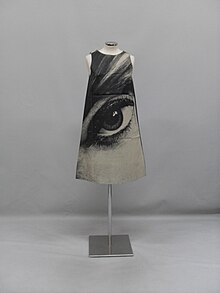Youthquake (movement)


Youthquake was a 1960s cultural movement. The term was coined by
Emergence
With the massive market of "baby boomers" coming into young adulthood, this generation challenged the norms of the past and were successful due to their large population. Women's economic, sexual, and social independence is seen as a catalyst that caused the many to reject the idealized femininity of the 1950s. In England, the emerging generation was bored of the couture houses' conservative designs and instead looked to boutiques to reinvent their style. This was a time in society when teenagers were able to explore their own identities and had the freedom to push boundaries due to post-World War II conditions. The boutique saw the start of the London ready-to-wear industry as people flocked for mass-produced clothing at a lower price point than its predecessors.
Mary Quant, often credited for inventing the mini-skirt, was a leader in the boutique movement and attributed her primary source of inspiration to the street style of the youth. Boutiques Biba, Bazaar and Paraphernalia housed talent like Betsey Johnson and Emmanuelle Khanh and utilized mass-production to fill their shops with the latest trends.[1] These boutiques were key players in London and the US as they were the first to cater specifically to the youth market with a modern approach: "clothes displayed like art in a gallery, cooler-than-thou young salesgirls, and rock and roll blaring from the speakers—shops that marketed clothes as part of a whole, deliriously amusing lifestyle".[2] The Scott Paper Company took advantage of mass-production and created disposable chemise dresses out of their patented Dura-Weave paper. Mass-production gave Scott the ability to print a diverse assortment of eye-catching patterns and Pop Art inspired motifs that appealed to the youth consumer.
The fashion of youthquake was fun, spirited and youthful – miniskirts, jumpsuits, and A-line silhouettes in bold colors were all the rage.[3] Trends like mod, Space Age, and hippie styles were birthed from this cultural phenomenon. Poster girls of the youthquakers such as Jean Shrimpton, Twiggy, Penelope Tree, Veruschka, and Edie Sedgwick were often on the cover of fashion magazines such as Vogue.[4][5] Pop icons like the Beatles and Jimi Hendrix were also used in advertising to reinforce fashion trends and drive sales.
In haute couture
Luxury designers like Andrè Courrèges and
Legacy
The concept of the "bubble-up" theory, where ideas and inspiration were taken from the
In December 2017,
See also
 1960s portal
1960s portal- Edie Sedgwick, original Youthquaker, 'It' girl
- Lana Del Rey, Neo-youthquake
- Phlo Finister, Neo-youthquake
- 2017 UK general election, when a swing in the youth vote to the left was called "youthquake" by many commentators.
References
- ^ Walford, Jonathan (2013). Sixties Fashion: From Less is More to Youthquake. New York: Thames & Hudson. pp. 34–52.
- ^ "The House of Mod". NYMag.com. Retrieved 2017-04-20.
- ^ Schwartzman, Tamsen. "Youthquake". sites.fitnyc.edu. Retrieved 2017-04-20.
- ^ "Fabulous faces of fashion: A century of modelling - Features, Fashion - The Independent". 2009-05-06. Archived from the original on 2009-05-06. Retrieved 2017-04-20.
{{cite web}}: CS1 maint: bot: original URL status unknown (link) - ^ Vogue, January 1, 1965, p 112
- ^ Steele, V (2010). The Berg Companion to Fashion. Oxford: Bloomsbury Academic.
- ^ "Youthquake' declared word of the year by Oxford Dictionaries". BBC News. 15 December 2017.
External links
- CNN-Cold War Experience: Culture (archived link)
- vintagefashionguide 1960s
